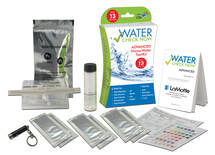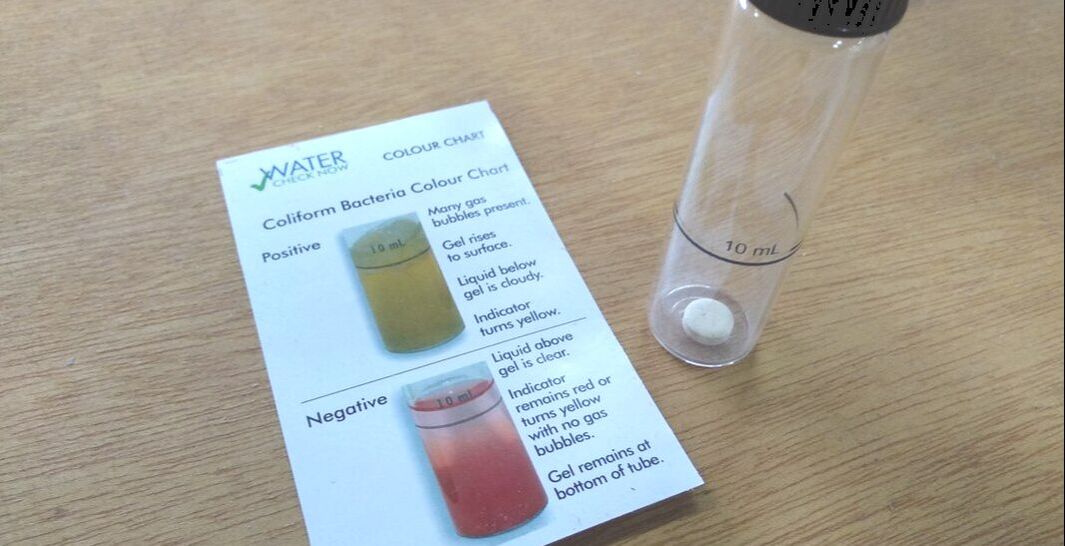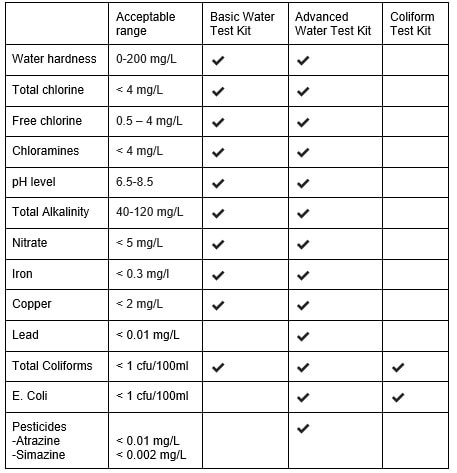|
Here at Wateroam, water quality is most important! We believe everyone deserves clean and safe water – which means you absolutely need to know what’s in your water before drinking it. This is especially important if you live or work in a location where the water isn’t filtered and/or treated. Depending on your needs, we have three test kits to offer that will help you identify whether your water is safe to consume: A total of 13 factors can be tested across these tests and, in this blog, we take you through each factor, the importance of testing them and the dangers of consuming them at unhealthy levels. Hard or soft?Water Hardness You might be familiar with the term 'hard water’ as it may have been the cause of issues in your very own household. Hard water interferes with almost every cleaning task, from laundering and dishwashing to bathing and personal grooming. Hard water can affect soap use as it prevents soap from foaming, and it can create build up of mineral deposits discoloring tiles and reducing water flow. This occurs because hard water has a high concentration of calcium and magnesium ions, created when water percolates through deposits of limestone, chalk or gypsum. While hard water is bad for our appliances, our clothes, and our hair, it is not a huge health hazard if consumed. The National Research Council (National Academy of Sciences) mentioned that hard drinking water generally contributes a small amount towards the total calcium and magnesium needed in our diet. However, if you have an iron, manganese, or a water hardness problem, the Water Research Centre recommends checking the arsenic levels. Arsenic is a dangerous and poisonous element found in some groundwater sources that dissolves out of certain rock formations. ChlorineTotal Chlorine Chlorination is the process of adding chlorine to water in order to disinfect it. This process is used to kill germs in pools and drinking water. Chlorine is harmful in high doses, but when calculated corrected and mixed thoroughly, the result is a chlorine level that can kill bacteria and viruses but is also safe for human use. Total chlorine is the is the sum of combined chlorine and free chlorine, both explained below. Total chlorine can be safe for consumption at 4mg/L, however some global health authorities suggest 2mg/L is the desired maximum to not impact the taste too significantly. Drinking water contaminated with unhealthy levels of chlorine has seen adverse health effects like cancer, increased risk of respiratory problems, skin issues and heart problems. Researchers have found that those exposed to chlorinated water over long periods of time have a greater risk of contracting cancer and carcinogenic cell damage. Additionally, risks of respiratory problems like asthma and skin irritation may occur in the airways of sensitive people with respiratory issues. When the skin is directly exposed to high levels of chlorine, itchiness, redness, blistering and swelling can occur. Therefore, monitoring the chlorine content in water is very important. Free Chlorine Free chlorine is the amount of chlorine that is available (or free) to sanitize contaminants and remove harmful microorganisms. It refers to both hypochlorous acid (HOCl) and the hypochlorite (OCl-) ion, also known as bleach, which are added to water systems for disinfection. This is important to measure because insufficient chlorine levels allow bacteria and other pathogenic microorganisms to multiply more quickly, leading to potential breeding grounds for water borne diseases. Chloramines (also known as Combined Chlorine) Chloramines are secondary disinfectants created when ammonia or organic nitrogen are added to chlorine; essentially it occurs when chlorine combines with contaminants. This creates a longer lasting disinfection when treating drinking water, as chlorine without ammonia dissolves quickly. There are three types of chloramines, each formed as a result of their own chemical reaction: monochloramine, dichloramines and trichloramines. They can be found in both municipal water systems and in swimming pools. As mentioned above under Total Chlorine, the consumption and interaction with chlorine on the body can cause irritation of the skin, eyes and respiratory track. Acidic or alkaline?pH level pH stands for “potential of hydrogen”, referring to the amount of hydrogen found in a substance, also reflecting how acidic or alkaline it is. The pH level measures a substance on a scale of 0 to 14, where pH 0-7 is acidic, pH 7-14 is alkaline, and pH7 is neutral. Consuming water that is over pH 8.5 may result in effects stated in the section 6 on Total Alkalinity (refer below). Consuming water below pH 6.5 includes exposure to heavy metals, oral damage, and high risks to children’s health. Drinking acidic water exposes your body to heavy metals and minerals present in the water , like iron, copper, manganese and zinc. Overexposure to these metals may lead to illness and poisoning. Acidic water also has a metallic and unsavory taste, which isn’t exactly desirable for consumption. Additionally, our mouths have many natural acids that break down food and bacteria; acidic water can result in teeth corrosion and damage to the soft gums. Filled with metals and contaminants, acidic water should not be consumed by anyone especially young children. Elevated levels of metal contaminants can cause severe health issues that could prove fatal or debilitating for children. Likewise, vomiting, diarrhoea, kidney disease, liver disease, stomach cramps, and nausea are among the leading health issues caused by acidic water consumption. Total Alkalinity Total alkalinity measures the water’s ability to neutralize acids. This is determined by measuring the levels of acid required to bring the pH level to 4.2, the point where no alkaline compounds exist. Alkaline compounds found in water, like hydroxides and carbonates, eliminate hydrogen ions from the water and decrease the water’s acidity level, therefore increasing the pH level. It is thus important to identify the water’s ability to neutralize the acidic or corrosive affect within water sources such as rainwater or wastewater. One negative side effect of consuming water with high total alkalinity includes the lowering of natural stomach acidity; stomach acid helps kill bacteria and prevents other undesirable pathogens from entering your bloodstream. Additionally, an excess of alkalinity in the body may cause gastrointestinal issues and skin irritations. The body’s normal pH may also be agitated, leading to metabolic alkalosis, where your blood becomes overly alkaline, causing nausea, vomiting and other serious symptoms. Natural contaminantsNitrate Nitrate is one of the most common groundwater contaminants; it originates primarily from fertilizers, septic systems, and manure usage. Nitrogen in fertilizer and manure that is not consumed by plants, volatilized, or carried away by surface runoff seeps to the groundwater in the form of nitrate. This then elevates the concentration of nitrate in groundwater to a level that is higher than acceptable for drinking water quality. Septic systems can also elevate groundwater nitrate concentrations as they remove only half of the nitrogen in wastewater, leaving the remaining half to percolate into groundwater. Nitrate in drinking water starts affecting the health of the general populace at levels in the range of 100 to 200 mg/l nitrate-N. However, the effect on any given person depends on many factors, including other sources of nitrate and nitrite in one’s diet. Methemoglobinemia is the most significant health problem associated with nitrate in drinking water. It is a condition that alters the hemoglobin in red blood cells and reduces its ability to carry oxygen from the lungs to the rest of the body. It can cause cyanosis, anoxia, and at higher levels, brain damage or death. Iron One of the earth’s most plentiful resources, iron makes up at least five percent of the earth’s crust. When rainfall seeps through the soil, the iron in the earth’s surface dissolves into almost every natural water supply, including well water. Iron often carries bacteria that feed off it and these small organisms can be harmful when digested. Additionally, if your iron levels are too high, iron overload or hemochromatosis, can cause liver, heart and pancreatic damage, and diabetes. Early symptoms include fatigue, weight loss, and joint pain. Excessive iron is never recommended for digestion as it can cause stomach problems, nausea, and vomiting, among other issues. Copper Copper is a metal that occurs naturally and is often used to make plumbing parts, roofing and industrial equipment. The primary way it can get into your household drinking water is from the water passing through your very own pipes; this occurs if the copper pipes are corroded, specifically from acidic water. Additionally, mining, farming and manufacturing are all ways copper can contaminate natural water sources, like rivers and lakes. While our bodies require some copper to stay healthy, too much copper is damaging. Eating or drinking high levels of copper can cause vomiting, diarrhoea, stomach cramps, nausea, liver damage, and kidney disease. To protect against short-term gastrointestinal tract problems, the US Environmental Protection Agency (EPA) mentioned that the maximum allowable level of copper in drinking water is 1.3mg/l while other health standards suggest up to 2mg/l is acceptable. Lead Lead is an unwelcome and dangerous environmental contaminant. It can be ingested from various sources, including lead paint and house dust contaminated by lead paint, as well as soil, drinking water, and food. The concentration of lead, total amount of lead consumed, and duration of lead exposure, all influence the severity of health effects. Since lead accumulates in the body, all sources of lead should be controlled or eliminated to prevent lead poisoning. Adverse health effects of lead exposure in children and adults are well documented; in children, there is no safe level of lead allowed in the bloodstream. At high levels of exposure, lead attacks the brain and central nervous system to cause coma, convulsions and even death. Lead is known to produce a spectrum of injury across multiple body systems. In particular, children’s brain development can be affected resulting in reduced intelligence, behavioral changes such as decreased attention span and increased antisocial behavior, and reduced educational capabilities, all of which are considered irreversible. Although the US EPA has set the maximum allowable concentration of lead in public drinking water at 15 µg/L, it is best that it contains no lead as it serves no beneficial purpose for our body. BacteriaTotal Coliforms The most basic test for bacterial contamination of a water supply, the total coliform count gives a general indication of the sanitary condition of a water supply. Total coliforms include bacteria that are found in the soil, in water that has been contaminated by surface water, and in human or animal waste. Fecal coliforms are the group of total coliforms that are present specifically in the gut and feces of warm-blooded animals. As their origins are more specific than those of more general coliforms, fecal coliforms are considered a more accurate indication of the amount of animal or human waste in the water supply. Coliform bacteria in drinking water can indicate a possible presence of harmful, disease-causing organisms like viruses, protozoa or bacteria. These can carry dangerous diseases that cause symptoms nausea, diarrhoea and dehydration; in severe cases or without treatment, they can cause death. E. Coli E. coli is a subset of total coliform and the major species in the fecal coliform group. It is generally not found growing and reproducing in the environment but it exists in the intestines of animals and humans. With many types of disease-causing organisms found in sewage, the presence of E. coli in water is a strong indication of recent sewage or animal waste contamination. Most varieties of e.coli are harmless or cause relatively brief diarrhea. However, a few particularly nasty strains, such as e.coli O157:H7, can cause severe abdominal cramps, bloody diarrhea and vomiting. Signs and symptoms of e.coli O157:H7 infection typically begin three or four days after exposure to the bacteria, though this can range between one to seven days. In less common cases, e.coli O157:H7 can cause kidney failure and even death. Water is only safe for consumption is there is no total coliform detectable per 100ml. Ready to buy your test kits now? click here to visit our store Check below |
Want more?Click below to see what other blog topics might peak your interest



Water Facts
|
- About Us
- Products
- Solutions
- Resources
- Get Involved
-
Blog
- The Global Water Situation
-
Facts about Water
>
- Water supplies for crisis
- WaSH During Emergencies
- Well Water Cleaning and Filtration Guide: Southeast Asia
- Gravity-fed Water Systems: Water Purification and Filtration setups in Southeast Asia
- A Guide to Rural Rainwater Harvesting and Filtering
- Water Shortages and Their Effect on Children in Rural Schools
- WaSH Planning and Design Framework Resources for Indonesia and the Philippines
- Rural Community Water Supply: Water Systems in Villages
- Info on our Products
- Impact Stories
- Upcoming & Past Events
- Contact
- Store
- About Us
- Products
- Solutions
- Resources
- Get Involved
-
Blog
- The Global Water Situation
-
Facts about Water
>
- Water supplies for crisis
- WaSH During Emergencies
- Well Water Cleaning and Filtration Guide: Southeast Asia
- Gravity-fed Water Systems: Water Purification and Filtration setups in Southeast Asia
- A Guide to Rural Rainwater Harvesting and Filtering
- Water Shortages and Their Effect on Children in Rural Schools
- WaSH Planning and Design Framework Resources for Indonesia and the Philippines
- Rural Community Water Supply: Water Systems in Villages
- Info on our Products
- Impact Stories
- Upcoming & Past Events
- Contact
- Store








.jpg)